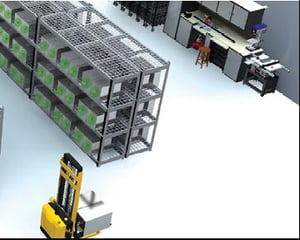 From the concrete of the production floor to the carpet in the executive offices, RFID technology provides actionable data which allows organizations to make complex business decisions. Making decisions based on actual data opposed to “best guess” data…I don’t even need to explain that. The trick is collecting that data and making it available for the organization. That is where RFID comes into play.
From the concrete of the production floor to the carpet in the executive offices, RFID technology provides actionable data which allows organizations to make complex business decisions. Making decisions based on actual data opposed to “best guess” data…I don’t even need to explain that. The trick is collecting that data and making it available for the organization. That is where RFID comes into play.
Work in Process is one of many applications within a plant in which RFID improves overall process efficiency. It helps to enable flexible manufacturing, tracks the work process, and helps to maintain regulatory compliance. Simply put, RFID technology is responsible for collecting the data, but it is up to the humans to use the data.
What is the data that is being recorded and collected?
- Build Data: What are we trying to build? (for flexible MFG)
- Process Data: How well did we build it? (Error Proofing or Poka Yoke)
- Lineage Data: Where did the parts come from? (Tracking sub-assemblies and parts to their origin)
How does this data benefit the manufacturing organization?
Build Data: Consider a company who is manufacturing seats for an automobile. The number of options on seats today is mind boggling. A few options include: Heaters, automated controls, weight sensors, specialized foam, specialized covers, etc. The problem is they all look the same to the human eye. When tagged with an RFID tag all that data is written to the memory in the beginning of the process and then the data is read at every work station along the line to identify exactly what needs to be done based on what the finished product is going to be. In the old days, the operator at each station would have to read through a couple reams of paper to determine what needs to be completed. Now an automatic data transfer informs the operator what needs to be completed.
Process Data: At the same seat manufacturer, let’s say there are twenty stations (processes) that a seat must go through in order to be completed. Now, let’s say there was an error installing the heating mechanism in station three. The seat then proceeds through the remaining seventeen stations getting many other things added to it along the way. Then, prior to shipping, it goes through final inspection and the heater problem is identified. Now, that final seat needs to be either scrapped or needs to go back through the rework line. That’s what used to happen in the old days. Nowadays there are error checks in between each station that quickly identify problems immediately opposed to waiting until the end of the line resulting in lost labor and time. As the seat moves from station three to four the error check occurs and either a go or no-go is written to the tag. If the reader in station four reads a no-go off the tag the operator is notified immediately and the production error can be corrected immediately without having to tear the seat apart to fix the problem. Additionally, the entire production process is written to the tag along the way and at the end of the line the information is uploaded to a database. The tag can then be erased and written to all over again.
Let’s say the seat manufacturer receives a special order that has to be run ASAP. All twenty seats currently on the line need to be removed to make way for the special order. After the special order is completed it’s now time to put the seats back in their respective stations. RFID takes the guess work out of that process because now they can just read the RFID tag and it will tell them the exact station it belongs in.
Lineage Data: All those seat variations mean many different components coming from many different suppliers. RFID is used to track those parts back to their origin in case of recall or repetitive part failure. Now instead of bringing the entire assembly back and scrapping the seat they can identify the faulty component, replace it, and hold their suppliers accountable to their quality promise.
Ultimately, from the concrete to the carpet, RFID helps manufacturing organizations make high quality products, eliminate un-planned down time, and improve overall efficiency. By allowing operators and executives to make decisions based on actual data, RFID is helping drive manufacturing organizations to the next level.
For more information on RFID solutions visit www.balluff.com.
























